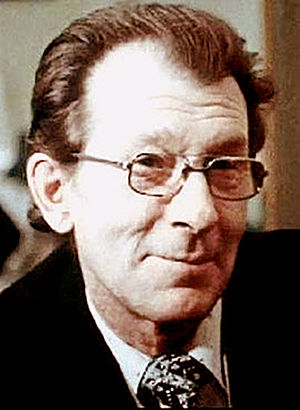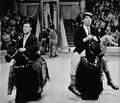Difference between revisions of "Mikhail Shuydin"
From Circopedia
(→Early and War Years) |
|||
| Line 9: | Line 9: | ||
Mikhail Ivanovich Shuydin (Михаил Иванович Шуйдин) was born on September 27, 1922, in the village of Kazachya, in the Tula region, just south of Moscow. His father, Ivan, was a shepherd, and his mother, Elizaveta Grigorievna, a factory worker. Mikhail lost his father at an early age and was brought up by his mother; they moved to Podolsk, an industrial center near Moscow. During his school years Mikhail attended after-school classes at the House of Art Education, where he learned to play percussion instruments and the basics of acrobatics. Then he began to work as a locksmith. | Mikhail Ivanovich Shuydin (Михаил Иванович Шуйдин) was born on September 27, 1922, in the village of Kazachya, in the Tula region, just south of Moscow. His father, Ivan, was a shepherd, and his mother, Elizaveta Grigorievna, a factory worker. Mikhail lost his father at an early age and was brought up by his mother; they moved to Podolsk, an industrial center near Moscow. During his school years Mikhail attended after-school classes at the House of Art Education, where he learned to play percussion instruments and the basics of acrobatics. Then he began to work as a locksmith. | ||
| − | [[File:Shuydin_Army.png|thumb|left|400px|Lieutenant Mikhail Shuydin (left) (1943)]]In May 1942, | + | [[File:Shuydin_Army.png|thumb|left|400px|Lieutenant Mikhail Shuydin (left) (1943)]]In May 1942, the Soviet Union entered World War II (known in Russia as The Great Patriotic War), and Shuydin was drafted into the Red Army and became a cadet in the 1st Gorky Tank School. After graduating with honors in the rank of lieutenant, he was sent to the Stalingrad Mechanized Corps, and took part in Operation Ring, which encircled Field Marshall Paulus's 6th Army in the Battle of Stalingrad. In 1943, Mikhail Shuydin was appointed commander in the 35th Guards Tank Brigade, in which he particularly distinguished himself; he was awarded the Order of the Red Star medal, a major Soviet military distinction. |
Shuydin’s military actions during WWII were quite remarkable, and he became a highly decorated officer. Injured many times, he suffered major burns in 1944 when his tank was set afire by a German missile. After a long sojourn in hospital, he was eventually discharged with the rank of Senior Lieutenant and was awarded the Order of the Red Banner medal, one of the highest distinctions of the USSR. | Shuydin’s military actions during WWII were quite remarkable, and he became a highly decorated officer. Injured many times, he suffered major burns in 1944 when his tank was set afire by a German missile. After a long sojourn in hospital, he was eventually discharged with the rank of Senior Lieutenant and was awarded the Order of the Red Banner medal, one of the highest distinctions of the USSR. | ||
Revision as of 19:58, 24 March 2022
Clown
By Dominique Jando
From 1950 to 1981, Yury Nikulin (1921-1997) and Mikhail Shuydin (1922-1983) formed the most celebrated clown duet of the Soviet Union and have since become two legendary figures of Russian Circus history. Although Yury Nikulin pursued a parallel career as a very successful movie actor that made him an iconic figure of Soviet (and Russian) cinema and contributed greatly to his immense popularity, Mikhail Shuydin held indeed his own in the ring, and the chemistry he created with Nikulin was, in no small part, the reason for the enduring success of the two clowns.
Early and War Years
Mikhail Ivanovich Shuydin (Михаил Иванович Шуйдин) was born on September 27, 1922, in the village of Kazachya, in the Tula region, just south of Moscow. His father, Ivan, was a shepherd, and his mother, Elizaveta Grigorievna, a factory worker. Mikhail lost his father at an early age and was brought up by his mother; they moved to Podolsk, an industrial center near Moscow. During his school years Mikhail attended after-school classes at the House of Art Education, where he learned to play percussion instruments and the basics of acrobatics. Then he began to work as a locksmith.
In May 1942, the Soviet Union entered World War II (known in Russia as The Great Patriotic War), and Shuydin was drafted into the Red Army and became a cadet in the 1st Gorky Tank School. After graduating with honors in the rank of lieutenant, he was sent to the Stalingrad Mechanized Corps, and took part in Operation Ring, which encircled Field Marshall Paulus's 6th Army in the Battle of Stalingrad. In 1943, Mikhail Shuydin was appointed commander in the 35th Guards Tank Brigade, in which he particularly distinguished himself; he was awarded the Order of the Red Star medal, a major Soviet military distinction.Shuydin’s military actions during WWII were quite remarkable, and he became a highly decorated officer. Injured many times, he suffered major burns in 1944 when his tank was set afire by a German missile. After a long sojourn in hospital, he was eventually discharged with the rank of Senior Lieutenant and was awarded the Order of the Red Banner medal, one of the highest distinctions of the USSR.
Back to civilian life, Mikhail Shuydin joined Moscow’s State College for Circus and Variety Arts, which had been created in 1927 to produce a new generation of Soviet circus performers. (The circus had been nationalized, along with the other performing arts, in 1919.) He graduated three years later, in 1948. Then he continued his training at the Clown Studio that was operating at the Old Circus on Tsvetnoy Boulevard. Attracted by comedy, Shuydin began his clown apprenticeship under the watchful eye of the Soviet Union's greatest clownGeneric term for all clowns and augustes. '''Specific:''' In Europe, the elegant, whiteface character who plays the role of the straight man to the Auguste in a clown team., Karandash (Mikhail Rumyantsev, 1901-1983). There, Shuydin met his future partner, Yury Nikulin.
Karandash (which means "Pencil" in Russian) had been one of the first graduates of Moscow's State College for Circus and Variety Arts. A very talented augusteIn a classic European clown team, the comic, red-nosed character, as opposed to the elegant, whiteface Clown. who had taken his inspiration from Charlie Chaplin, Karandash had become extremely popular, even more so during "The Great Patriotic War," when his sarcastic parodies of Hitler and the German army offered comic relief (and revenge) to a population caught in the nightmare of a German military invasion.
Nikulin & Shuydin
Karandash took Shuydin under his wing and made him one of his assistants, a role that Shuydin shared with young Yury Nikulin. Shuydin’s debut in the ring went well: Small in stature, Shuydin portrayed a self-important director, and Karandash was pleased by the way audiences reacted to his pupil’s comic impersonation. Mikhail Shuydin was on his way to becoming a talented augusteIn a classic European clown team, the comic, red-nosed character, as opposed to the elegant, whiteface Clown.. In 1950, Shuydin and Nikulin began to work together.Their clown characters were different, and thus complementary: Whereas Nikulin was tall, shy, and gangly, Shuydin was short, neat, self-important, a daring (and hapless) go-getter. It was a perfect comedic balance. The year 1950 saw other changes: Nikulin (who was now married) and Shuydin had a disagreement with Karandash over work. They decided to leave him and go their own way. Nikulin and Shuydin, along with Tanya, Nikulin’s young wife, who participated in some of their entrées, went on to tour the Soviet circus circuit and honed their skills in front of increasingly appreciative audiences.
Their growing success led them to become staples of Mosow's Old Circus on Tsvetnoy Boulevard, the Soviet Union's premier circus, which served as a showcase for the USSR's major circus stars—of which, by the late 1950s, there were many. To a large extent, Nikulin and Shuydin had supplanted Karandash as Russia's favorite clowns: They had now a large repertoire of entrées and reprises; their humor was similar to Karandash's in many respects, but Karandash was aging and Nikulin and Shuydin were better attuned to the times.
Their fame also got a significant boost when, in 1958, Nikulin began to work in movies: Playing comic characters quite similar to his clown persona, he soon became a major star in that medium. Nonetheless, he continued to work with Mikhail Shuydin, shooting films in the afternoon and appearing in the ring in the evening. Mikhail Shuydin and Yury Nikulin became major stars of the Soviet circus and remained a team until they both retired from the ring in 1981. Shuydin, whose health was deteriorating, was sixty-one, and his partner was sixty.
Epilogue
Sadly, Mikhail Shuydin didn’t take advantage of his retirement: He passed away in Moscow on August 24, 1983, following a long illness. Although Yury Nikulin is better remembered today than Mikhail Shuydin through his films, some of which have become Russian cult classics, as a clown duet, Shuydin and Nikulin cannot be separated. They made their entire circus career together, and were always billed equally, neither one appearing more important than the other. Their vast repertoire was entirely conceived around their two complementary characters, and it is this complementarity that made their success.Mikhail Shuydin was made Honored Artist of the Russian Federative Soviet Socialist Republic in 1969 and People’s Artist of the Russian Federative Soviet Socialist Republic in 1980. With his wife, Zinaida Efimovna, he had two sons: Vyacheslav Nikhailovich, who had a relatively short career as a circus performer due to an accident, and Andrey Mikhailovich (born 02/08/1958), who was both a ice-hockey player and a circus acrobat, and, starting in 1989, worked for Moscow’s Circus On Ice company. Andrey retired in 2005.
Mikhail Ivanovich Shuydin was buried at Moscow’s Kuntsevo Cenetery, where he was rejoined by his wife, Zinaida, in 1995.
See Also
- Biography: Yury Nikulin
- Video: Yury Nikulin & Mikhail Shuydin, The Weight Lifter, at the Old Circus on Tsvetnoy Boulevard (c.1965)
- Video: Yury Nikulin & Mikhail Shuydin, The Vodka Bottle, at the Old Circus in Moscow (1967)
- Video: Yury Nikulin & Mikhail Shuydin, Hig School reprise, at the Old Circus on Tsvetnoy Boulevard in Moscow (1967)
- Video: Yury Nikulin & Mikhail Shuydin, Death of a Bureaucrat, at the Old Circus on Tsvetnoy Boulevard (c.1968)
- Video: Yury Nikulin & Mikhail Shuydin, The Log, at the Old Circus in Moscow (c.1970)
- Video: Yury Nikulin & Mikhail Shuydin, snake reprise, at the Old Circus in Moscow (c.1970)
- Video: Yury Nikulin & Mikhail Shuydin, The Bet, at the Old Circus in Moscow (1981)
- Video: Yury Nikulin & Mikhail Shuydin, The Upsizing Machine, at the Old Circus in Moscow (1981)
- Video: Yury Nikolin & Mikhail Shuydin, The Television Set at the Old Circus in Moscow (1981)
















